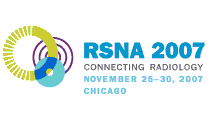
Abstract Archives of the RSNA, 2007
SSC20-09
Whole Heart Coronary Magnetic Resonance Angiography for the Detection of Coronary Stenoses: A Multicenter Study
Scientific Papers
Presented on November 26, 2007
Presented as part of SSC20: Cardiac (MR)
Yasutaka Ichikawa MD, Presenter: Nothing to Disclose
Hajime Sakuma MD, Abstract Co-Author: Research grant, Philips Electronics, Japan
Research grant, General Electric Company, Japan
Research grant, Toshiba, Japan
Research grant, Schering AG, Japan
Research grant, Daiichi Pharmaceutical Corporation, Japan
Research grant, Eisai Co, Ltd, Japan
Yasuyuki Kobayashi MD, Abstract Co-Author: Nothing to Disclose
Masaki Ishida MD, Abstract Co-Author: Nothing to Disclose
Kazuhiro Katahira, Abstract Co-Author: Nothing to Disclose
Yuji Matsumoto MD, Abstract Co-Author: Nothing to Disclose
Naoya Fujita MD, Abstract Co-Author: Nothing to Disclose
Reiji Ochiai MD, PhD, Abstract Co-Author: Nothing to Disclose
et al, Abstract Co-Author: Nothing to Disclose
et al, Abstract Co-Author: Nothing to Disclose
To prospectively determine the diagnostic performance of whole-heart coronary magnetic resonance (MR) angiography for detecting significant coronary artery disease.
This prospective multicenter trial was performed at 5 clinical sites each under institutional ethics committee approval. Three-dimensional coronary MR angiograms covering the entire heart were obtained during free breathing in 58 patients. Images were acquired during a patient-specific time window in the cardiac cycle with minimal motion of the coronary artery. MR angiograms were evaluated by 3 independent observers. Significant coronary artery disease was defined on X-ray coronary angiography as a diameter reduction of ≥50% in coronary arteries with a reference diameter of ≥2 mm.
Significant luminal narrowing (≥50%) was observed on coronary angiography in 17 (29%) of 58 patients. The averaged sensitivity, specificity and negative predictive value of whole heart coronary MRA for detecting patients having significant stenoses in at least one coronary artery was 79.4% (range 64.7-88.2%), 70.1% (65.9-80.5%), and 89.6% (84.6-93.1%), respectively. The averaged sensitivity, specificity and negative predictive value on segment based analysis was 60.6% (53.8-65.4%), 95.5% (94.2-97.6%), 97.7% (97.4-98.1%), respectively.
The results in the current multi-institutional study demonstrated that whole-heart coronary MR angiography allows for noninvasive detection of significant coronary artery disease with moderate sensitivity, high specificity and high negative predictive value.
Because of high negative predictive value, whole heart coronary MRA is useful in screening coronary artery disease without radiation or nephrotoxicity.
Ichikawa, Y,
Sakuma, H,
Kobayashi, Y,
Ishida, M,
Katahira, K,
Matsumoto, Y,
Fujita, N,
Ochiai, R,
et al, ,
et al, ,
Whole Heart Coronary Magnetic Resonance Angiography for the Detection of Coronary Stenoses: A Multicenter Study. Radiological Society of North America 2007 Scientific Assembly and Annual Meeting, November 25 - November 30, 2007 ,Chicago IL.
http://archive.rsna.org/2007/5013682.html

